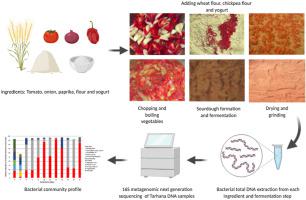Food Bioscience ( IF 4.8 ) Pub Date : 2020-11-30 , DOI: 10.1016/j.fbio.2020.100824 Ali Soyuçok , Mediha Nur Zafer Yurt , Osman Altunbas , Veli Cengiz Ozalp , Mert Sudagidan

|
Tarhana is one of the favourable traditional fermented food consumed as a soup. Different flour, vegetables, spices and yogurt are main constituents and they compose of microbiota of Tarhana. In this study, bacterial communities in each fermentation process and in their constituents were identified by metagenomic analysis. Also, chemical properties (pH, acidity, salt content and dry matter) were analysed in each step. The results showed that in the dough formation, mainly Lactobacillus, Bacillus, Enterococcus and Streptococcus were present and after Day 4, Clostridium and Bacillus became dominant, after drying Clostridium disappeared and in the final product bacterial communities from Bacillus and Streptococcus genus were observed. Chemical analysis showed that pH decreased from 4.94 to 4.46, acidity increased by time at the beginning of fermentation from 7.5% to 22.5% in first 6 days period, then, became stable at 14% in drying process. Salt content increased by time from 1.74 to 3.08 g salt/100 g Tarhana in first 8 days and in drying process salt content was recorded as 2.81–2.90 and dry matter was obtained as 94 g dry matter/100 g Tarhana in the final product. This study elucidated the effects of ingredients, raw materials and how microbiota and chemical properties changes during fermentation steps of home-made traditional Tarhana production and thus preparation methods could be developed to obtain standardized Tarhana products for industrial production in future.
中文翻译:

塔哈纳传统发酵过程的元基因组学和化学分析
塔哈纳(Tarhana)是作为汤食用的有利的传统发酵食品之一。不同的面粉,蔬菜,香料和酸奶是主要成分,它们由塔尔哈纳菌群组成。在这项研究中,通过宏基因组分析确定了每个发酵过程中细菌群落及其组成。同样,在每个步骤中分析化学性质(pH,酸度,盐含量和干物质)。结果表明,在面团形成过程中,主要存在乳杆菌,芽孢杆菌,肠球菌和链球菌,第4天后,干燥梭状芽胞杆菌后梭状芽孢杆菌和芽孢杆菌成为优势菌。杆菌和链球菌消失了,最终产物中的细菌群落观察属。化学分析表明,pH值从发酵前的6天开始从7.94降低到4.46,在发酵开始时随着时间的推移酸度从7.5%增加到22.5%,然后在干燥过程中稳定在14%。在最初的8天中,盐含量随时间从1.74增加到3.08 g盐/ 100 g Tarhana,在干燥过程中,最终产品中的盐含量记录为2.81-2.90,获得的干物质为94 g干物质/ 100 g Tarhana。这项研究阐明了成分,原料的影响,以及在传统的传统塔哈纳生产的发酵步骤中微生物群和化学性质的变化,因此可以开发制备方法以在将来获得用于工业生产的标准化塔哈纳产品。











































 京公网安备 11010802027423号
京公网安备 11010802027423号